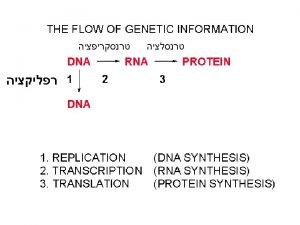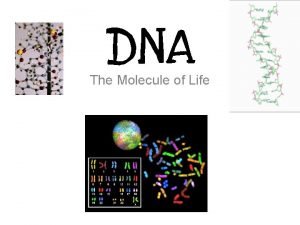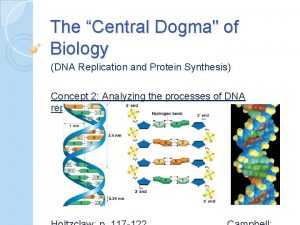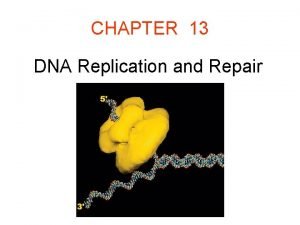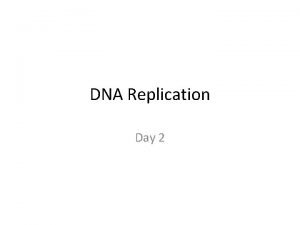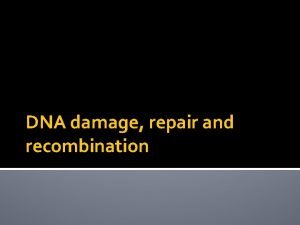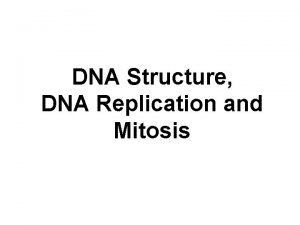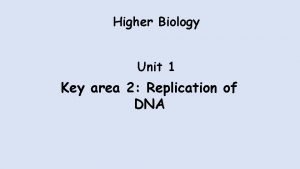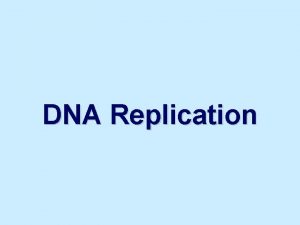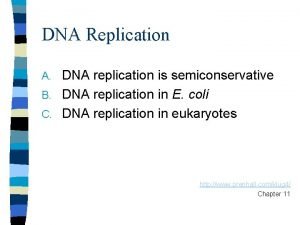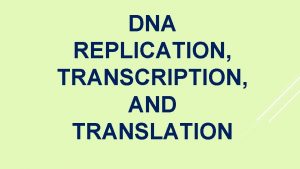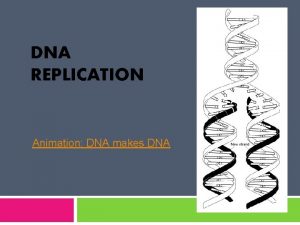DNA Replication DNA Replication Origins of replication 1













- Slides: 13

DNA Replication

DNA Replication • Origins of replication 1. Replication Forks: Forks hundreds of Y-shaped regions of replicating DNA molecules where new strands are growing. 5’ Parental DNA Molecule 3’ 3’ Replication Fork 5’

DNA Replication • Origins of replication 2. Replication Bubbles: Bubbles a. Hundreds of replicating bubbles (Eukaryotes) b. Single replication fork (bacteria). Bubbles

DNA Replication • Strand Separation: Separation 1. Helicase: Helicase enzyme which catalyze the unwinding and separation (breaking HBonds) of the parental double helix. 2. Single-Strand Binding Proteins: Proteins proteins which attach and help keep the separated strands apart.

DNA Replication • Strand Separation: Separation 3. Topoisomerase: Topoisomerase enzyme which relieves stress on the DNA molecule by allowing free rotation around a single strand. Enzyme DNA Enzyme

DNA Replication • Priming: 1. RNA primers: primers before new DNA strands can form, there must be small pre-existing primers (RNA) present to start the addition of new nucleotides (DNA Polymerase) 2. Primase: Primase enzyme that polymerizes (synthesizes) the RNA Primer.

DNA Replication • Synthesis of the new DNA Strands: 1. DNA Polymerase: Polymerase with a RNA primer in place, DNA Polymerase (enzyme) catalyze the synthesis of a new DNA strand in the 5’ to 3’ direction 5’ 3’ Nucleotide DNA Polymerase RNA Primer 5’

DNA Replication 2. Leading Strand: Strand synthesized as a single polymer in the 5’ to 3’ direction 5’ 3’ 5’ Nucleotides DNA Polymerase RNA Primer

DNA Replication 3. Lagging Strand: Strand also synthesized in the 5’ to 3’ direction, direction but discontinuously against overall direction of replication. Leading Strand 5’ 3’ DNA Polymerase RNA Primer 3’ 5’ 5’ 3’ 3’ 5’ Lagging Strand

DNA Replication 4. Okazaki Fragments: Fragments series of short segments on the lagging strand. DNA Polymerase Okazaki Fragment RNA Primer 5’ 3’ Lagging Strand 3’ 5’

DNA Replication 5. DNA ligase: ligase a linking enzyme that catalyzes the formation of a covalent bond from the 3’ to 5’ end of joining stands. Example: joining two Okazaki fragments together. DNA ligase 5’ 3’ Okazaki Fragment 1 Lagging Strand Okazaki Fragment 2 3’ 5’

Question: • What would be the complementary DNA strand for the following DNA sequence? DNA 5’-GCGTATG-3’

Answer: DNA 5’-GCGTATG-3’ DNA 3’-CGCATAC-5’
 Bioflix activity dna replication lagging strand synthesis
Bioflix activity dna replication lagging strand synthesis Dna polymerase function in dna replication
Dna polymerase function in dna replication Dna and genes chapter 11
Dna and genes chapter 11 Direction of helicase
Direction of helicase Dna replication steps
Dna replication steps Bioflix dna replication
Bioflix dna replication Dna replication is considered semiconservative because
Dna replication is considered semiconservative because Orc dna replication
Orc dna replication Dna replication
Dna replication Enzyme involved in dna replication
Enzyme involved in dna replication Dna structure and replication packet answer key
Dna structure and replication packet answer key Accuracy of dna replication
Accuracy of dna replication Dna structure and replication
Dna structure and replication Dna replication higher biology
Dna replication higher biology



